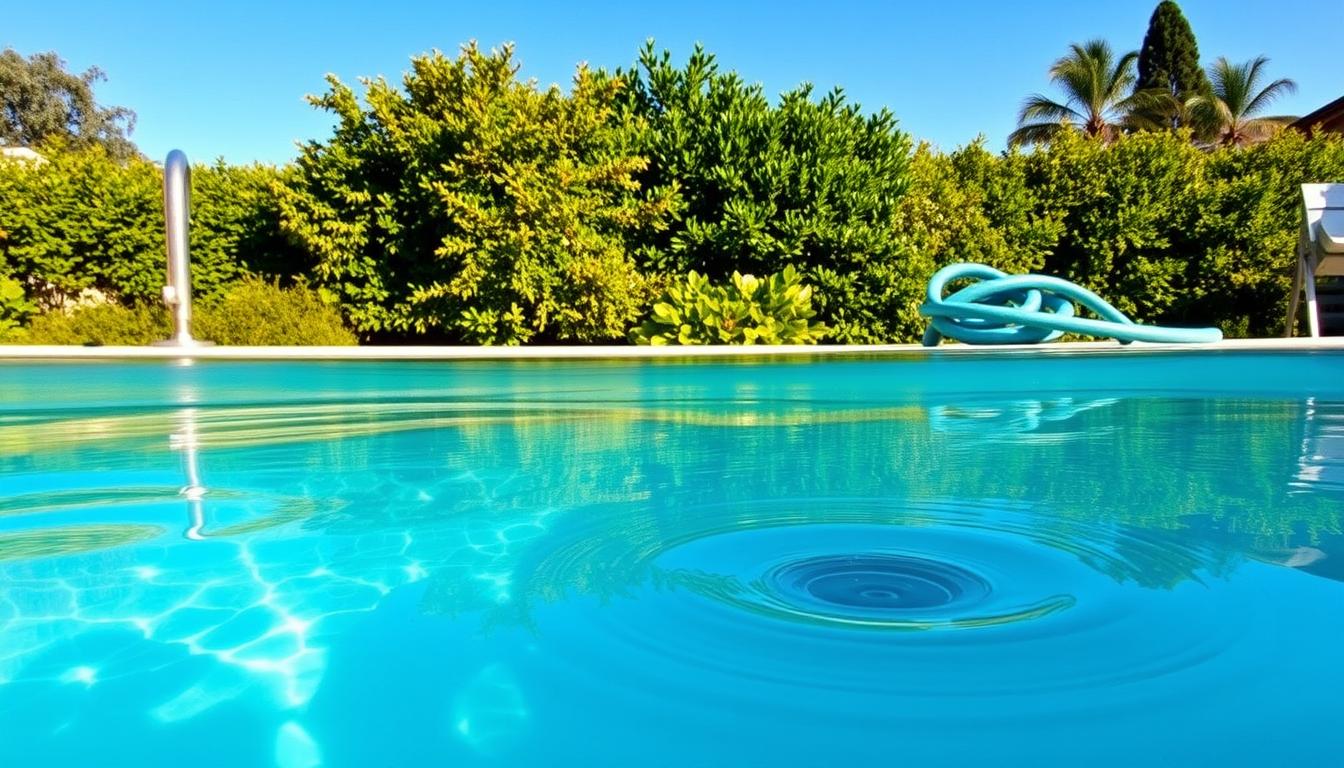
Pool owners sometimes need to drain their pool below the skimmer level. This might be for closing, repairs, replastering, or vinyl replacement. Before draining, check your local rules about water runoff. This guide will help you safely drain your pool below the skimmer.
Draining a large pool can lead to a hefty water bill. Most pools hold 18,000 to 20,000 gallons of water. The draining process can take 8 to 14 hours, depending on pool size and pump strength.
Refilling can take a few hours for small pools. Larger ones might need up to 14 hours. This is based on a 4 to 12 gallon per minute flow from an outdoor spigot.
There are four main ways to drain your pool. You can use the filter waste port, pump’s hose bib, sump pump, or garden hose. Your filter system and drainage amount will determine the best method.
Follow our guide and local rules to lower your pool water level safely. This ensures a smooth process for winterizing or maintaining your pool.
Key Takeaways
- Plan ahead and research your local municipality’s rules regarding pool water runoff before draining your pool.
- Consider the weather conditions and budget for water replacement when preparing to drain your pool.
- Choose the most suitable draining method based on your pool’s filter system and the amount of water you need to remove.
- Follow safety precautions and monitor the draining process closely to avoid damage to your pool or surrounding areas.
- Lowering the pool water level below the skimmer is crucial for winter preparation to prevent water expansion damage due to freezing temperatures.
Preparing to Drain Your Pool
Draining your pool requires careful planning. First, check local laws and consider weather conditions. Don’t forget to budget for refilling the pool.
Check Local Municipality Laws and Regulations
Local laws often dictate where and when you can drain pool water. Check your town’s rules before emptying thousands of gallons.
Some places ban draining into streets or storm drains. Ensure your water is pH neutral, chlorine-free, and environmentally safe.
Consider Weather Conditions
Drain your pool when it’s 85°F (29°C) or cooler to avoid damage. Hot weather can cause cracks or blisters in the liner.
Choose mild weather for draining. This helps minimize the risk of pool damage.
| Weather Condition | Recommended Action |
|---|---|
| 85°F (29°C) or lower | Safe to drain pool |
| Above 85°F (29°C) | Avoid draining pool to prevent damage |
Budget for Water Replacement
Remember, you’ll need to refill your pool after draining. This can be costly, so plan ahead.
Refilling costs vary based on pool size and local water rates. It can range from hundreds to thousands of dollars.
Proper planning is key to successful pool draining. Follow regulations, protect your pool, and manage refilling costs.
Draining Your Pool Using a Submersible Pump
A submersible pump is an efficient tool for draining your pool. Gather all necessary equipment before starting. Take precautions to protect your pool equipment during the process.
Optional: Drain Through Multiport Valve
For pools with sand or D.E. filters, you can partially drain through the multiport valve. Set it to “WASTE” and drain until water reaches the skimmer line’s bottom. This can be a convenient first step before using a submersible pump.
Unplug Pool Equipment
Unplug all pool equipment before draining. This includes the pump, lights, and automatic timers. Disconnecting the power supply prevents damage, especially when draining below the skimmers.
Attach Hose to Submersible Pump
Connect a garden hose or discharge hose to the pump outlet. Place the pump underwater, at least to your desired draining endpoint. Secure the hose connection to prevent leaks during draining.
Direct Hose to Drain Point
Choose a proper drain point that follows local rules. Options include sewers, roads, yards, or wooded areas. Position the hose downhill from the pool to avoid backflow issues.
Plug in Pump and Monitor Draining Process
Plug the pump into a GFCI outlet once everything is set up. Check that water flows freely without hose obstructions. Monitor water levels periodically as draining can take several hours or more.
Keep an eye on the pump’s strainer basket to prevent debris damage. Regular monitoring ensures a successful pool draining experience.
Remember, proper maintenance and care of your pool equipment, such as the submersible pump and hoses, will extend their lifespan and ensure efficient performance for future draining tasks.
How to Drain Pool Below Skimmer Using a Siphon
Siphoning is a cheap way to drain pool water below the skimmer. It’s a gravity-based method that needs little effort and gear. While slower than a pump, it’s hands-free and saves on power costs.
You’ll need a long garden hose to reach from your pool to a lower drainage point. Fill the hose with water, keeping both ends level. Place one end at the desired pool level and the other at the drain.
Make sure the drain end is lower than the pool end. This keeps the siphon going. Water will flow from the pool to the drain due to gravity.
Watch the process and move the hose as needed. Aim for 3 to 6 inches below the skimmer for good winterizing. This method is slow but cost-effective for winter prep.
Check local rules for water disposal before draining. Proper draining and other tasks like balancing chemicals protect your pool. This ensures an easy opening in spring.







